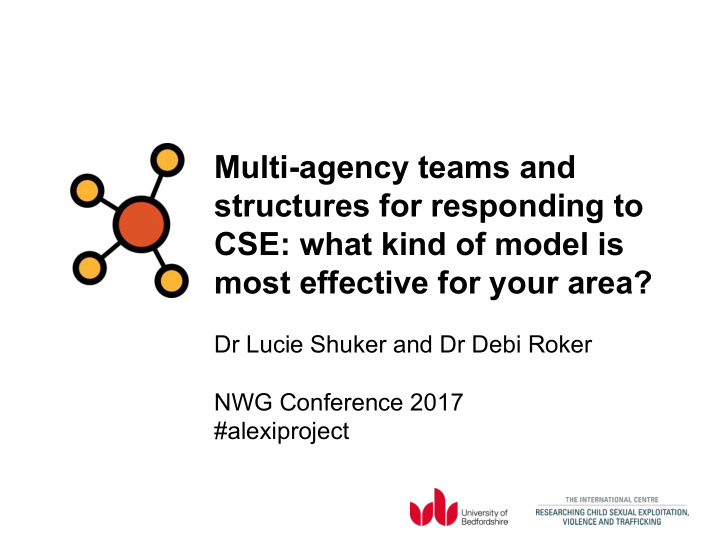



Multi-agency teams and structures for responding to CSE: what kind of model is most effective for your area? Dr Lucie Shuker and Dr Debi Roker NWG Conference 2017 #alexiproject
The Alexi Project 16 Hub services, 48 Spokes Three-phase rolling funding program Three-year evaluation to test the effectiveness of the ‘Hub and Spoke’ model
Alexi Project: outcomes tracked Services secure a source of sustainable funding for the 1. continuation of Spoke services Spokes become successfully embedded into existing 2. services / CSE service landscape Spoke workers retain a distinctive identity and role 3. focused on CSE The geographical reach of specialist CSE services is 4. extended Skill levels in partner agencies regarding identifying and 5. responding to CSE are improved. Outcomes improve for young people supported by Spoke 6. services.
Model 1 The statutory model
Model 2 The community model
Model 3 The outreach model
Model 4 The mixed model
Model 5 The spoke team model
Discussion in pairs • What is your role? • What are the key features of your local multi-agency arrangements in relation to CSE? • How do the voluntary and statutory agencies relate in terms of these structures? • What do you think are the key factors driving the development of your local multi-agency structures/cultures?
Strengths/weaknesses Join with another pair and form a four • What are the strengths of your local approach to multi- • agency structures and working? Any key messages/tips you would want to pass on? • Is there one particular challenge you face in relation to • multi-agency working and CSE?
Feedback
Overcoming challenges: ideas
Alexi Project Some messages on multi- agency structures
The key aspects of context that shape MA structures – including A – Historical and current relationships locally • B – CSE profile / police operations locally • C – Activities and priorities of key organisations locally • (LSCB, CSE co-ordinators, police etc)
Effective voluntary and statutory partnerships A – Identifying and agreeing lead agencies locally • B – Problem profiles and development of strategy • C – Leadership and MA ‘push’ • D – Proactively removing barriers (eg info sharing) •
Charity Service Manager’s view about effective multi-agency working …. “I think that is one of the biggest lessons, because what makes something successful or not, is the individuals… so you can have the best agreements, you can have the best documents, but they’re only going to be implemented if there are people who are determined to make it work.”
Implications for you What, if any, key messages or actions do you want to take away for your practice, service or area?
www.alexiproject.org.uk for reports
debi.roker@beds.ac.uk lucie.shuker@beds.ac.uk www.alexiproject.org.uk www.beds.ac.uk/ic
Recommend
More recommend